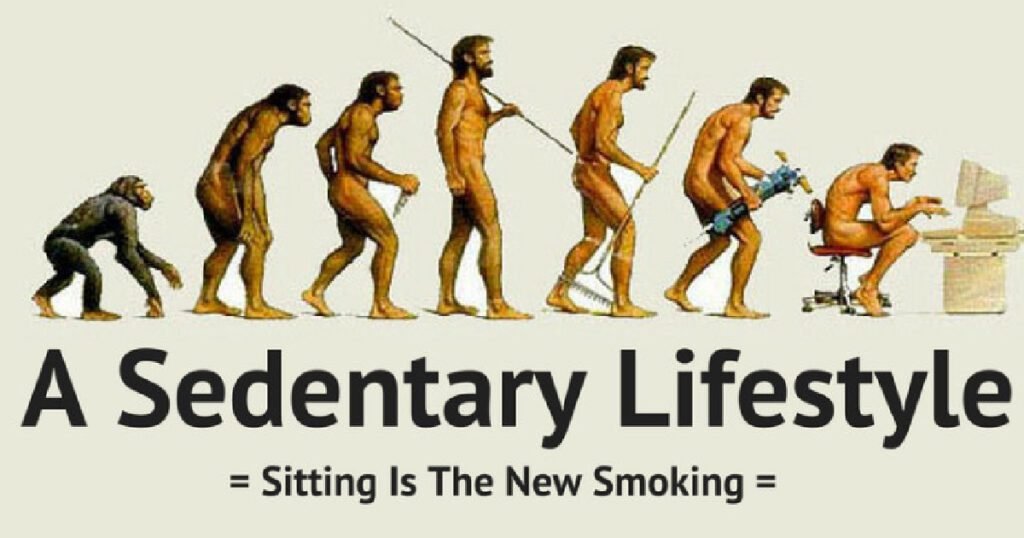Introduction
What exactly is a Sedentary Lifestyle?
Walking or cycling are simple and effective ways to fight back against a sedentary lifestyle, which typically involves too much sitting – four withdraws: work, car seat, couch at night; three deposits. That usually includes sitting in the car and watching TV or lying down – anything that is not moving, such as working at your computer.
Understanding A Sedentary Lifestyle
As sedentary living has become a norm in recent society, it is vital to comprehend its implications. This knowledge can help reduce subsequent health risks AND promote more physically active and healthier lifestyles.
Overview of Health Risks
Being sedentary as we know, is responsible for many common health issues like obesity, cardiovascular diseases diabetes, etc. And it adds to the mental health problems – depression, and anxiety.
Societal Impact
Segments of the population who spend more time in sedentary behavior may experience even larger direct and indirect costs including increased healthcare expenditures, reduced work productivity (due to lost work time accompanying morbidity), as well as lower quality of life.
Types and Categories
Occupational sitting
Work-related sedentary behavior includes sitting or low physical activity while at work. You see this quite often in office-type environments where a worker is sat at a table for however long.
Sedentary Recreation
Leisure or recreational sedentary behavior: Inactive activity is done during leisure time. [=[Examples AS: Television viewing, playing video games computer use and smartphone use.)
Domestic Sedentary Behavior
This includes sitting during domestic activities, such as reading or doing kitchen work with little movement.
Why do we sacrifice physical activity in children?
Nowadays children do a lot of sedentary activities which are not good for their physical health, and developing of foot-to-hand skills.
Sedentary Behavior in Adults
As this Imgur post reveals, most adults are forced to sedentary lives as a result of their work requirements; commuting, and recreational activities until they age into debilitating diseases setStateSugar
Sedentary Behavior in the Elderly
Older persons with mobility problems or lack of motivation may end up doing less physical activity resulting in adverse effects on their health.
Symptoms and Signs
Physical Symptoms
Weight gain Muscle weakness Poor posture: and the list goes on! Over time, these may result in chronic conditions like heart disease and diabetic issues.
Mental and Emotional Symptoms
It is known that a sedentary lifestyle can cause mental health to deteriorate, leading as much energy towards anxiety and depression while also impacting memory concerning cognitive performance. The lack of exercise again, the other day experienced low energy or mood swings?
Long-Term Health Consequences
Sedentary lifestyles can lead to chronic diseases, and longer-term health consequences add years of reduced quality of life.
Causes and Risk Factors
Technological Advancements
On a positive note, many tasks can now be done easily, thanks to technological innovations. However, sadly these very conveniences are also fuelling a sedentary lifestyle by reducing the amount of physical activity required for any work.
Urbanization
The process of urbanization has spawned obesogenic environments characterized by car-oriented designs and increased availability of leisure options that require little physical activity[6].
Work Culture
Many of us are working 8 hours a day for others who sit on chairs. And our work contributes to the sedentary lifestyle we lead now which as I have been stressing is killing people en masse!
Insiders’ View on My Habits and Preferences
Sedentary habits of everyday living are due in part to individual choices regarding sedentary leisure activities as opposed to those that are more active.
Age and Gender Differences
Screen time varies by age and gender, with women somewhat more likely to be inactive due in part to social norms.
Socioeconomic Factors
The ACSM said that such socioeconomic factors as income or education influence how available the resources to support an active lifestyle are–things like gyms and recreational facilities.
Diagnosis and Tests
Physical Activity Questionnaire
A physical activity questionnaire is widely used to determine the level of an individual’s activities and identify sedentary behavior patterns.
Wearable Activity Trackers
Commercially available wearable activity trackers provide granular real-time physical activity data to be used by individuals and their healthcare providers in monitoring sedentary behavior.
Medical Examinations
Being a part of frequent medical examiners is critical for detecting sedentary lifestyle-associated illnesses and disability such as obesity, hypertension, HTN, and diabetes mellitus DM: healthy people.
Assessing Lifestyle Factors
It is no mystery that a sedentary lifestyle harms health, and the extent of time spent exercising in this situation depends on how it disrupts an individual’s eating habits as well as their daily activities.
Treatment Options
Increasing Physical Activity
One of the best treatments for a sedentary lifestyle is physical activity, whether it’s in exercise form (regularly) or daily life behaviors.
Ergonomic Interventions
Protective Wearables Protective wearables such as sit-stand workstations, and ergo chairs ensure that your body is at much less risk of physical damage due to long hours in a chair.
Behavioral Therapy
Notably, behavioral therapies can improve sedentary behaviors by using cognitive and behavioral techniques to reshape a lifestyle into an active one.
Support Programs for the Community and Workplace
BackgroundCommunity and worksite programs (CWPs) aimed at promoting physical activity have been shown to reduce sedentary behavior among participants.
Role of Healthcare Providers
In addition to helping in the prevention of NF and other diseases, healthcare providers have a unique opportunity here as well – raising awareness among patients on how much time should be spent sitting before it becomes harmful.
Preventive Measures
Encouraging Active Lifestyle
Promote a lifelong active lifestyle early to combat the possibility of adopting sedentary behavior and ensure good overall health from youth.
Creating active workspaces
The results might help to increase the efficacy of workplace interventions focusing on sedentary behavior and contribute even more than simple environmental changes like standing desks or different kinds of active breaks.
Educational Campaigns
An array of education campaigns focusing on the health risks associated with a sedentary lifestyle have the power to encourage them towards more active daily habits.
Policy Interventions
Policy efforts to support active transportation and the development of physical activity spaces can address population-level reductions in sedentary behavior.
Role of Families and Schools
Families and schools need to support healthy habits, and physical activity instead of screen time consumption in children.
Case studies or personal stories
The Real World Effect of a Sedentary Lifestyle
Examples from real life demonstrate the powerful influence of an inactive lifestyle on people’s health and well-being requirements reform.
Lifestyle Success Stories
This blog discovers the personal success stories of those, who have switched from inactive to an active life and how they did it.
Expert Testimonials
Professionals providing tips on living a healthy lifestyle, such as healthcare workers and fitness professionals, reinforce this message.
Expert Insights
Medical Professionals’ Views
Health-wise, doctors point out the dangers of a sedentary lifestyle and why it is better to engage in physical activities regularly.
Fitness Experts’ Advice
Fitness experts share some practical tips on how they find the time to exercise.
Psychological Perspectives
The benefits of exercise for mental health are explored by psychologists.
Conclusion
Summary of Key Points
Key takeaways: Sedentary behavior contributes to serious health risks through decreased physical activity associated with lifestyle and sedentary behavior.
Lifestyle Change Call to Action
Urging readers to adopt a more active lifestyle including setting daily activeness goals and talking with healthcare providers.




